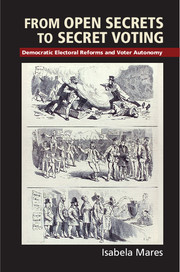Book contents
- Frontmatter
- Contents
- Figures
- Tables
- Acknowledgments
- 1 Introduction
- 2 The Protection of Voters' Autonomy
- 3 Electoral Intimidation by State Employees
- 4 Electoral Intimidation by Employers
- 5 The Production of Irregularities during Elections: A Quantitative Analysis
- 6 The Adoption of Electoral Reforms
- 7 Labor Scarcity, Rural Inequality, and Electoral Reforms: The Determinants of Electoral Reform in the Prussian Electoral System
- 8 Voting for Opposition Candidates: Economic Concentration, Skills, and Political Support for Social Democracy
- 9 Dilemmas on the Right and the Road to Proportional Representation
- 10 From Macro- to Micro-Historical Analysis in Comparative Research
- References
- Index
- Other Books in the Series
4 - Electoral Intimidation by Employers
Published online by Cambridge University Press: 05 July 2015
- Frontmatter
- Contents
- Figures
- Tables
- Acknowledgments
- 1 Introduction
- 2 The Protection of Voters' Autonomy
- 3 Electoral Intimidation by State Employees
- 4 Electoral Intimidation by Employers
- 5 The Production of Irregularities during Elections: A Quantitative Analysis
- 6 The Adoption of Electoral Reforms
- 7 Labor Scarcity, Rural Inequality, and Electoral Reforms: The Determinants of Electoral Reform in the Prussian Electoral System
- 8 Voting for Opposition Candidates: Economic Concentration, Skills, and Political Support for Social Democracy
- 9 Dilemmas on the Right and the Road to Proportional Representation
- 10 From Macro- to Micro-Historical Analysis in Comparative Research
- References
- Index
- Other Books in the Series
Summary
The absence of economic freedom leads to the absence of political freedom.
(Dr. Förster, Neustettin, Stenographische Berichte des Deutschen Reichstages May 15, 1895: 2290)Chapter 3 documented the existence of a wide variety of strategies of electoral intimidation carried out by employees of the state. In addition to policemen and tax collectors, private economic actors also played a dominant role as agents of electoral intimidation. During elections, companies turned into political battlegrounds. Private actors mobilized voters at the workplace, regimented them in columns, and marched them to the polls. Supervisory personnel of these companies ensured that voters entered the precinct equipped with the “correct” ballots. Employer representatives located in close proximity to the voting place maintained voting counter-lists (Gegenlisten) that recorded the electoral choices made by each and every employee. Using this information, employers engaged in post-electoral reprisals by punishing voters who had made incorrect electoral choices. Among the strategies of post-electoral punishments used by employers, the strategy that imposed the highest costs on voters involved being laid off for having made the wrong electoral choice.
In this chapter, I draw on the historical evidence presented in the electoral reports of the parliamentary commission charged with examining electoral irregularities to document pre- and post-electoral strategies used by private economic actors and the regional and temporal variation in these strategies. The main source of my analysis is a subset of reports on electoral fraud, which comprises 15 percent of the contested elections of the period. Using this subset of the total number of electoral reports, I code in greater detail whether instances of electoral intimidation by employers were present and the types of strategies used by private actors in elections. This qualitative evidence allows me to disaggregate the incidences of intimidation across different stages of the electoral process and examine when voters were most vulnerable to pressure from employers.
- Type
- Chapter
- Information
- From Open Secrets to Secret VotingDemocratic Electoral Reforms and Voter Autonomy, pp. 67 - 92Publisher: Cambridge University PressPrint publication year: 2015



